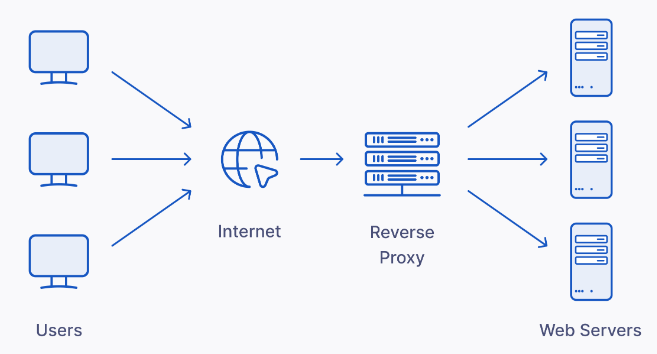Reverse Proxy In System Design | SDE Interview

A reverse proxy is a type of proxy that is used to forward requests from the internet to a server in a private network. It is typically used to provide security, improve performance, or handle load balancing.
When a client makes a request, the request is first sent to the reverse proxy, which then forwards the request to the intended server. The server responds to the proxy, which in turn forwards the response to the client. The client is unaware that their request is being proxied and sees the response as if it came directly from the intended server.
Use Cases of Reverse Proxy
One of the main use cases for a reverse proxy is to provide security for web servers and applications. A reverse proxy acts as a gateway to the internal network and can be configured to inspect traffic and enforce security policies. This can help protect the network from threats such as malware, phishing, and DDoS attacks.
Another use case for a reverse proxy is to improve performance by handling load balancing. A reverse proxy can distribute incoming traffic across multiple servers, which can help to ensure that the servers are able to handle the load and provide a better user experience.
A reverse proxy can also be used to handle SSL offloading. SSL (Secure Sockets Layer) is a security protocol that is used to encrypt communications between a client and a server. SSL offloading is the process of moving the SSL encryption and decryption from the web server to the reverse proxy. This can help to improve performance by reducing the load on the web server.
In addition to these use cases, a reverse proxy can also be used to provide additional functionality such as caching, compression, and content rewriting.
It is important to note that a reverse proxy also can be a potential security risk. A reverse proxy that is not properly configured or maintained can be exploited by attackers to gain access to the network. To mitigate this risk, it is important to ensure that the reverse proxy is properly configured and maintained. This includes keeping the proxy software up to date, configuring security policies, and monitoring the proxy for signs of suspicious activity.
Conclusion
In conclusion, a reverse proxy is a type of proxy that is used to forward requests from the internet to a server in a private network. It is an essential tool for providing security, improving performance, and handling load balancing. When properly configured and maintained, a reverse proxy can provide significant benefits to an enterprise network. However, it is important to be aware of the potential security risks and take steps to mitigate them.
Thanks 🤗.
To Hire/Connect? LinkedIn
P.S.: If you like this uninterrupted reading experience on this beautiful platform of Medium.com, consider supporting the writers of this community by signing up for a membership HERE. It only costs $5 per month and helps all the writers.
A clap would be highly appreciated if you liked what you just read. You can be generous in clapping; it shows me how much you enjoyed this story. And if you didn’t like it? Please do comment😋!
